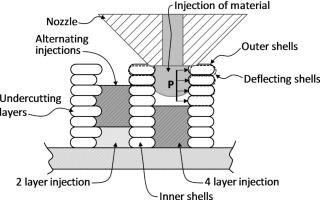Additive Manufacturing ( IF 11.0 ) Pub Date : 2020-07-20 , DOI: 10.1016/j.addma.2020.101469 David O. Kazmer , Austin Colon

|
Material extrusion is a popular process for both prototyping and digital manufacturing, yet it is lacking in terms of part strength, feature resolution, and production rate relative to alternative processes. Injection printing addresses these issues by combining material extrusion of the outer surfaces of the part at fine resolution with injection molding of larger interior cavities at high flow rates. Injection printing thus aims to utilize the full melting capacity of material extrusion printers to mitigate the curse of dimensionality that plagues additive manufacturing. Simple governing models for flow in the formed cavities as well as the stress and deflection of the shell walls are presented. To validate the performance of injection printing relative to material extrusion, impact specimens and tensile bars were printed of acrylonitrile butadiene styrene (ABS). The tensile and impact results of the samples were compared, and image analysis was performed on the post-test samples. It was found that injection printing increased print speeds by an average factor of 3.2 relative to conventional material extrusion using the same linear print velocities. With respect to properties, the stiffness, strength, and strain to failure of injection printed tensile bars (in-plane) were respectively increased by 21 %, 47 %, and 35 % compared to material extrusion. Properties of impact specimen and vertically printed tensile bars also showed promising gains albeit with constraints related to the printer’s melting capacity. Even still, injection printing is shown as a broadly applicable and readily accessible process for increasing part strength and production rate while enabling improved feature resolution without greatly extended print times.
中文翻译:

注塑:通过外壳材料挤压和填充进行增塑成型
对于原型制造和数字制造而言,材料挤压是一种流行的工艺,但是相对于替代工艺而言,它在零件强度,特征分辨率和生产率方面都缺乏。注射印刷通过将高分辨率的零件外表面材料挤压与高流速的较大内腔的注射成型相结合来解决这些问题。因此,注射印刷旨在利用材料挤出印刷机的全部熔化能力来减轻困扰增材制造的尺寸诅咒。给出了在型腔中流动以及壳壁的应力和挠度的简单控制模型。为了验证注射印刷相对于材料挤出的性能,冲击试样和拉伸棒由丙烯腈丁二烯苯乙烯(ABS)印刷而成。比较样品的拉伸和冲击结果,并对测试后的样品进行图像分析。已经发现,相对于使用相同线性印刷速度的常规材料挤出,注射印刷将印刷速度提高了3.2倍的平均速度。在性能方面,与材料挤压相比,注射印刷的拉伸杆(面内)的刚度,强度和破坏应变分别提高了21%,47%和35%。冲击试样和垂直打印的拉伸杆的性能也显示出令人鼓舞的增长,尽管受到与打印机熔化能力有关的限制。即使如此


























 京公网安备 11010802027423号
京公网安备 11010802027423号